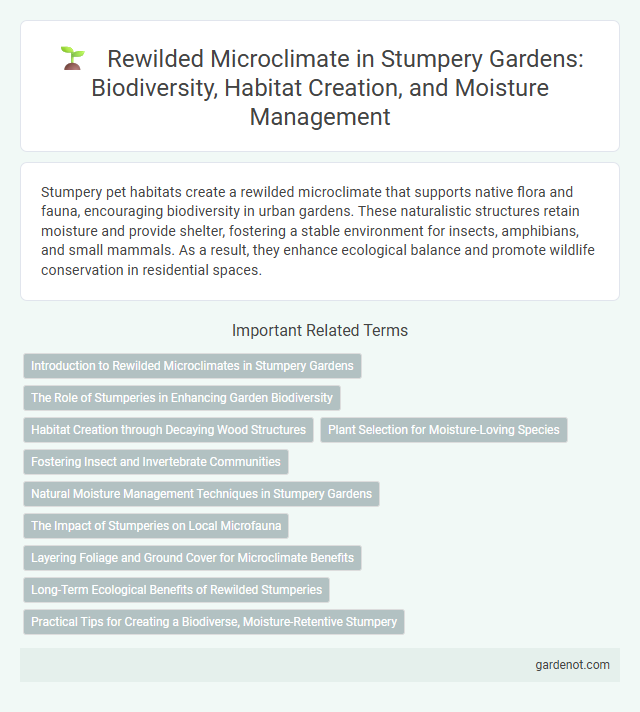Stumpery pet habitats create a rewilded microclimate that supports native flora and fauna, encouraging biodiversity in urban gardens. These naturalistic structures retain moisture and provide shelter, fostering a stable environment for insects, amphibians, and small mammals. As a result, they enhance ecological balance and promote wildlife conservation in residential spaces.
Introduction to Rewilded Microclimates in Stumpery Gardens
Rewilded microclimates in stumpery gardens create unique ecological niches by harnessing natural processes around decomposing wood and dense planting. These microhabitats support diverse species of fungi, moss, insects, and amphibians, promoting biodiversity and ecological balance within garden environments. Stumperies optimize soil moisture retention and temperature regulation, fostering resilient native flora and wildlife adapted to shaded, humid microclimates.
The Role of Stumperies in Enhancing Garden Biodiversity
Stumperies create a rewilded microclimate by providing sheltered, moist habitats that support a diverse range of invertebrates, fungi, and mosses, significantly enhancing garden biodiversity. Their intricate arrangements of decayed wood offer refuge and breeding grounds for beneficial insects and amphibians, promoting ecological balance. By mimicking natural woodland conditions, stumperies facilitate species richness and contribute to resilient garden ecosystems.
Habitat Creation through Decaying Wood Structures
Stumpery designs utilize decaying wood structures to create a rewilded microclimate that supports diverse habitat formation by providing shelter, moisture retention, and nutrient-rich environments. These rotting logs and stumps foster populations of fungi, invertebrates, and small mammals, enhancing local biodiversity. By mimicking natural forest floor conditions, stumperies promote ecological succession and soil health within rewilded garden spaces.
Plant Selection for Moisture-Loving Species
Selecting moisture-loving plants such as ferns, hostas, and marsh marigolds enhances the rewilded microclimate of a stumpery by retaining humidity and supporting biodiversity. These species thrive in damp, shaded environments created by decaying wood, which naturally regulates soil moisture and temperature. Incorporating native moisture-tolerant plants improves ecological balance and fosters a resilient habitat for amphibians and pollinators.
Fostering Insect and Invertebrate Communities
A stumpery creates a rewilded microclimate by providing decaying wood habitats that support diverse insect and invertebrate communities essential for ecosystem health. The shaded, moist environment encourages colonization by beetles, spiders, and fungi, enhancing biodiversity and nutrient cycling. These microhabitats contribute to pollination, soil aeration, and natural pest control within gardens and natural landscapes.
Natural Moisture Management Techniques in Stumpery Gardens
Stumpery gardens utilize natural moisture management techniques by harnessing the shade and moisture-retaining properties of decaying wood to create a rewilded microclimate. The organic structure of stumps and logs enhances soil humidity, fostering a habitat for moisture-loving plants like ferns and mosses. This sustainable approach optimizes water retention and supports biodiversity by mimicking natural forest floor conditions.
The Impact of Stumperies on Local Microfauna
Stumperies create a rewilded microclimate that fosters biodiversity by providing shelter, moisture retention, and stable temperature conditions. These structures support local microfauna such as amphibians, insects, and fungi by mimicking natural woodland environments, enhancing ecosystem complexity. Research shows that stumperies increase habitat availability, promoting species richness and ecological resilience in fragmented landscapes.
Layering Foliage and Ground Cover for Microclimate Benefits
Layering foliage and ground cover in a stumpery creates a rewilded microclimate that enhances biodiversity by providing shelter and moisture retention. Dense undergrowth combined with varied plant heights stabilizes soil temperature and reduces evaporation, fostering a humid environment ideal for fungi, mosses, and invertebrates. This natural layering also promotes carbon sequestration and supports a resilient ecosystem by mimicking woodland floor conditions.
Long-Term Ecological Benefits of Rewilded Stumperies
Rewilded stumperies create diverse microhabitats that support native flora and fauna, enhancing biodiversity over time. The decaying wood provides essential nutrients, promoting soil health and fostering mycorrhizal networks crucial for plant growth. These long-term ecological benefits contribute to resilient ecosystems capable of adapting to climate change and environmental disturbances.
Practical Tips for Creating a Biodiverse, Moisture-Retentive Stumpery
Plant shade-tolerant ferns, mosses, and native woodland species around decaying stumps to enhance moisture retention and support biodiversity in a rewilded microclimate. Incorporate natural mulch such as leaf litter and pine needles to conserve soil moisture and provide habitat for beneficial insects and fungi. Position stumps strategically to create shaded, damp microhabitats that encourage diverse flora and fauna to thrive.
Rewilded microclimate Infographic

 gardenot.com
gardenot.com